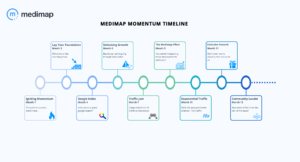- June 29, 2023
Digital Marketing Strategies for Your Practice: Reaching and Engaging Your Target Audience
The Importance of Digital Marketing for Your Practice
Identifying Your Target Audience: Understanding Who You're Trying to Reach
Research and Gather Information:
Start by researching and gathering information about your potential patients. Consider their age range, interests, and the specific healthcare services they are seeking. This will help you create a comprehensive profile of the type of people you want to attract to your practice.Tailor Your Strategies:
Understanding your target audience allows you to tailor your digital marketing strategies to resonate with them more effectively. Craft compelling messages and create content that addresses their specific needs and concerns. For example, if your target audience consists of young adults seeking dermatology services, focus on highlighting the latest skincare trends or addressing common skin issues faced by this age group.Select Appropriate Channels:
Identifying your target audience enables you to select the most appropriate digital marketing channels to reach them. If your target audience primarily uses social media platforms like Instagram or Facebook, allocate resources to create engaging social media campaigns that capture their attention.Establish Connection:
The goal is to establish a connection with your target audience by understanding their preferences, desires, and pain points. This insight will guide your digital marketing efforts, enabling you to craft messages that resonate with them on a deeper level and increase the likelihood of them choosing your practice for their healthcare needs.Creating a Solid Digital Marketing Strategy: Key Steps to Success
Set Clear Goals:
Start by setting specific and measurable goals for your practice’s digital marketing efforts. Determine what you want to achieve, such as increasing website traffic, generating more leads, or boosting appointment bookings. Clear goals provide direction and allow for progress tracking.Identify Target Audience and Choose Methods:
Once you have identified your target audience, select the digital marketing methods most likely to reach and engage them. This could involve improving your website’s visibility on search engines through techniques like search engine optimization (SEO). It could also include leveraging social media platforms, such as Facebook or Instagram, to connect with your audience and build brand awareness. It can also involve signing up for platforms and search directories like Medimap, as this improves visibility, enabling you to reach a broader audience and ultimately grow your practice more effectively. Additionally, consider using email marketing campaigns to reach interested individuals directly, as well as online advertising to expand your reach to a broader audience.
Develop a Detailed Plan:
Create a comprehensive plan that outlines the specific steps to execute your digital marketing strategy. Determine timelines for each tactic, whether it’s website optimization, social media campaigns, targeted emails, or other activities. Allocate a budget to ensure sufficient resources for effective execution.Stay Organized and Accountable:
Having a well-structured plan helps you stay organized, focused, and accountable. Regularly review and measure the results of your digital marketing efforts to identify successful tactics and areas for improvement. Adjust your strategy as needed to optimize your approach.Developing a Compelling Website: Optimizing User Experience and Conversion
User-Friendly Website Design:
Create a website that is easy to navigate, loads quickly, and functions seamlessly across devices. A fast and responsive website enhances user satisfaction and encourages visitors to explore further.Clear Calls-to-Action:
Incorporate clear and intuitive buttons or links that guide visitors toward specific actions. For example, prominently display a “Book Appointment” button that directs potential patients to easily schedule a visit or provides a clear contact form for inquiries. By making it effortless for visitors to take action, you can enhance the likelihood of converting them into actual patients.Engaging and Trust-Building Content:
Craft compelling and informative content that highlights your practice’s expertise, services, and unique value proposition. Include patient testimonials, success stories, and relevant educational resources to showcase your credibility and expertise. By providing valuable information, you build trust with potential patients and position your practice as a reliable source of healthcare.Convenient Functionality:
Implement features like live chat support or online appointment scheduling to make it easier for visitors to engage with your practice. Convenient functionalities increase the chances of visitors choosing your services.Monitor and Analyze Performance:
Regularly monitor and analyze your website’s performance using tools like Google Analytics. Gain insights into visitor behavior, identify areas for improvement, and refine your website over time.Conclusion
To easily search, compare and book an appointment with a health provider near you, visit medimap.ca.




